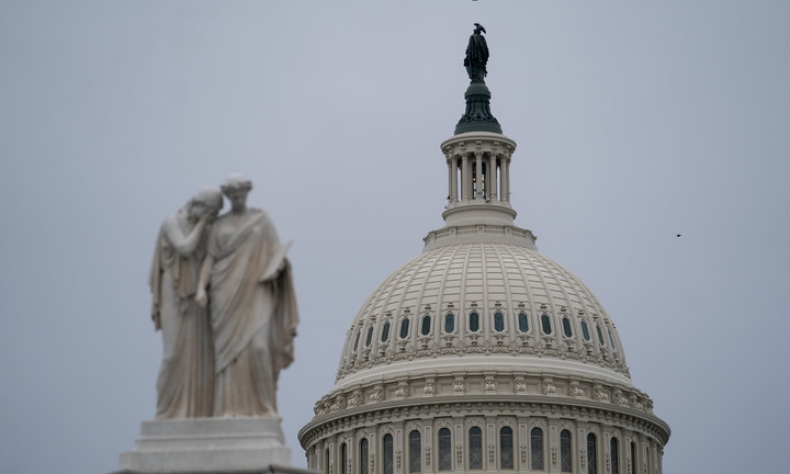Worsening Credit

The fiscal and debt difficulties confronting the U.S. have not improved. Instead, they have become worse.
Fitch Ratings downgraded the United States’ long-term foreign-currency issuer default rating (IDR) from “AAA” to “AA+” on August 1, raising concerns among global investors about the U.S. credit. This is the second time in America’s history that a top-three U.S. ratings firm has downgraded its IDR, after Standard & Poor’s in 2011 lowered its rating one notch below the top grade. The move leaves Moody’s as the only of the three big ratings firms still giving the U.S. the AAA rating.
Why did the rating agency choose to downgrade the U.S. sovereign rating at this time, despite the bipartisan agreement in early June to suspend the debt limit until January 2025? According to a report released by Fitch on August 1, the move reflects “the expected fiscal deterioration over the next three years,” “a high and growing general government debt burden” and “the erosion of governance” over the past two decades “that has manifested in repeated debt limit standoffs and last-minute resolutions.” In reality, these reasons are quite similar to those given by Standard & Poor’s when it downgraded the U.S. sovereign rating in 2011, indicating the fiscal and debt difficulties confronting the U.S. have not improved. Instead, they have become worse.
Burdensome load
The long-standing federal deficit in the United States has grown increasingly severe in recent years. If no emergency measures are taken, the budget deficit is set to balloon to its highest levels, seen only during World War II and the COVID-19 pandemic. Additionally, the U.S. Government continues to expand its debt to the extent that paying it off would require $94,000 from each American citizen. High inflation is also exerting pressure on the economy, leading to a continuous rise in the consumer price index (CPI). These challenges hold back the economic recovery of the U.S.

The federal fiscal deficit has nearly doubled. Over the past half-century, the average deficit has been around 3.5 percent of gross domestic product (GDP), already considered excessive spending. After the outbreak of the pandemic in early 2020, the U.S. Government responded to the crisis with massive fiscal stimulus, pushing the fiscal deficit to $3.13 trillion and $2.77 trillion in 2020 and 2021, respectively, both exceeding 10 percent of GDP. Even though the deficit fell to $1.38 trillion in 2022, the deficit-to-GDP ratio remained high at 5.5 percent. From last October through June, the budget gap had already hit $1.39 trillion, a 170-percent increase from the same period last year. The federal government operates under a fiscal year that starts from October 1.
Based on the latest estimate from the Congressional Budget Office (CBO), the fiscal deficit as a percentage of GDP will rise to 6.3 percent in 2023, 6.6 percent in 2024, and a further widening to 6.9 percent in 2025.
The burden of debt continues to increase. As it ran large and expanding budget deficits during the pandemic, the federal government’s debt soared to $31.4 trillion in early 2023 from a pre-pandemic level of $23.2 trillion, and topped $32.6 trillion in June when the debt limit agreement was reached. The debt-to-GDP ratio rose to 120 percent, ranking behind only Japan, Greece and Italy among Organization for Economic Cooperation and Development (OECD) countries. This might raise questions about the U.S. ability to maintain long-term financial stability and address potential economic risks associated with high levels of indebtedness. The CBO projected the U.S. debt level will double by 2050, reaching nearly 250 percent of GDP.
A higher interest burden adds to the medium-to-long-term payment pressures. A country’s capacity to handle interest payment is a determinant of its debt sustainability. The low interest rates in the U.S. that have remained since the 2008 financial crisis have helped alleviate the country’s debt pressure. However, the elevating inflation since 2021 has prompted the Federal Reserve to sharply increase interest rates, resulting in the yield on 10-year government bonds exceeding 4 percent, which intensified the interest burden. In the first three quarters of the 2023 fiscal year, the Treasury interest cost grew 25 percent to $652 billion, contributing to the substantial expansion of the budget deficit. Thus the prevailing belief in the financial market is that both high inflation and high interest rates will persist for an extended period. The CBO predicted that by 2033, the U.S. interest expenses will surpass defense expenditures by one third to reach $1.4 trillion. The immense spending has undoubtedly worsened the U.S. deficit and debt burden, and sparked concerns about the country’s debt-paying capacity.

Management dysfunction
As the U.S. Government runs on a large yearly budget deficit, the debt ceiling has been raised 104 times since 1940, or once every nine months. In 2011, a deal on the debt ceiling was reached just hours before the Treasury estimated it would run out of money to meet its financial obligations. This time, again, Washington reached an agreement only a few days before a default. In recent years, the amount by which the debt ceiling is raised has been getting smaller while the frequency of the raises has been increasing. The U.S. debt limit has been raised 12 times since the start of the 21st century, with notably seven of them occurring after the 2008 financial crisis. But the persistent concern regarding the borrowing limit has failed to draw significant attention and halt the ongoing rise in U.S. debt, with the ceiling surging from $45 billion in 1939 to the current $31.4 trillion.
This reflects the political polarization where both parties are locked in impasses over fiscal issues, but both are poor at long-term fiscal management planning. Generally, the White House tends to push for a debt ceiling increase to accommodate expanded government spending. The “opposition party,” especially when in control of Congress, aims to impede such increases. Once the “opposition party” rules, their attitudes toward the issue often reverse. In essence, the U.S. electoral system makes long-term planning difficult, as the primary focus of successive administrations remains on delivering quick results.
Risks loom large
Both the U.S. and global financial markets experienced severe turbulence when Standard & Poor’s first downgraded the U.S. sovereign rating in 2011. Markets this time, however, have been rather stable. Following Fitch’s report, the yield on the 10-year Treasury bond increased slightly to over 4.1 percent, the NASDAQ index dropped by more than 2 percent and the U.S. Dollar Index rose again to 102. Overall, the market’s response has been moderate, and the impact has not spilled over into other financial markets. This could be attributed to the fact that the current economic fundamentals of the U.S. remain relatively strong. But it’s worth noting the substantial U.S. debt and the low debt risk are largely sustained by the U.S. dollar’s status as an international reserve currency, and the massive U.S. debt market is upheld by the global demand for U.S. Treasuries. This also invisibly erodes the credibility of the U.S. dollar as investor confidence in both the dollar and U.S. Treasuries cannot be sustained indefinitely.
The author is a research fellow with the Institute of American Studies under the Chinese Academy of Social Sciences.
 Facebook
Facebook
 Twitter
Twitter
 Linkedin
Linkedin
 Google +
Google +










